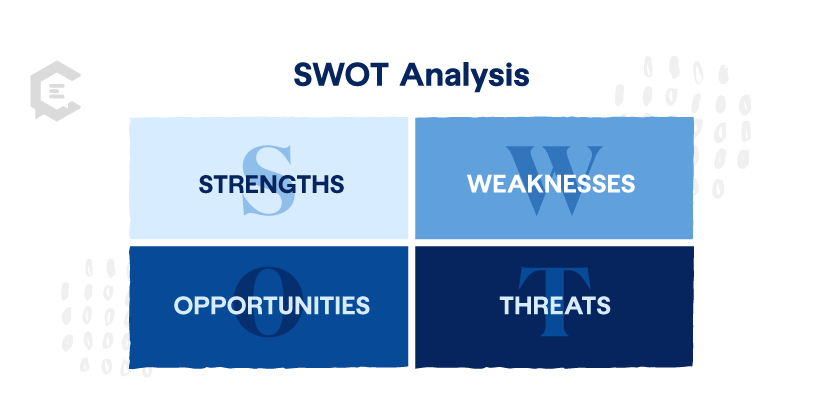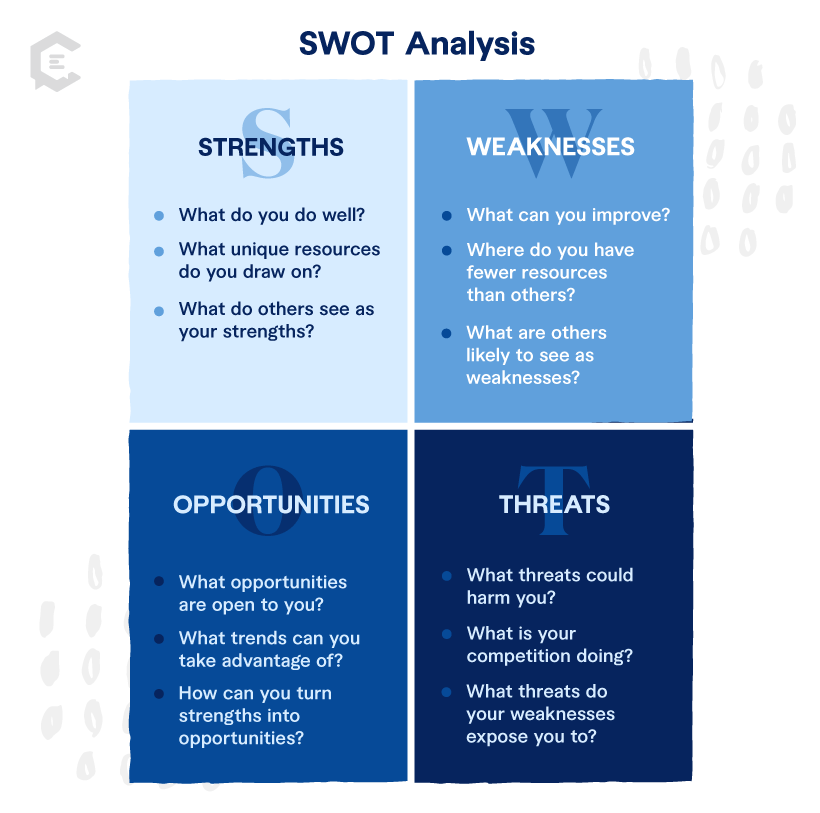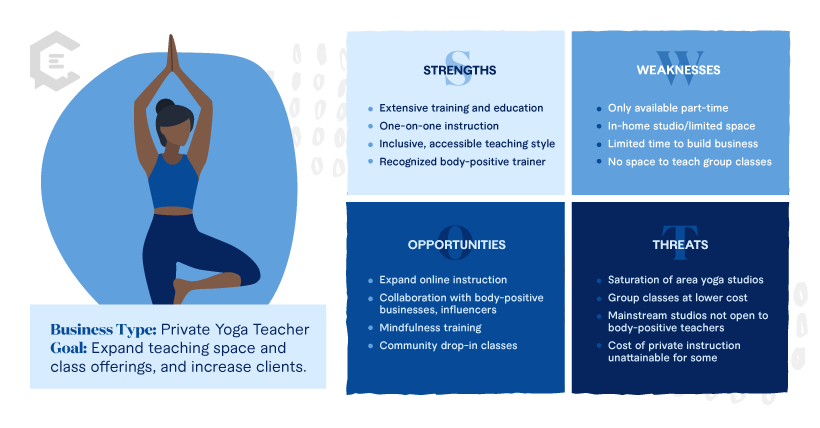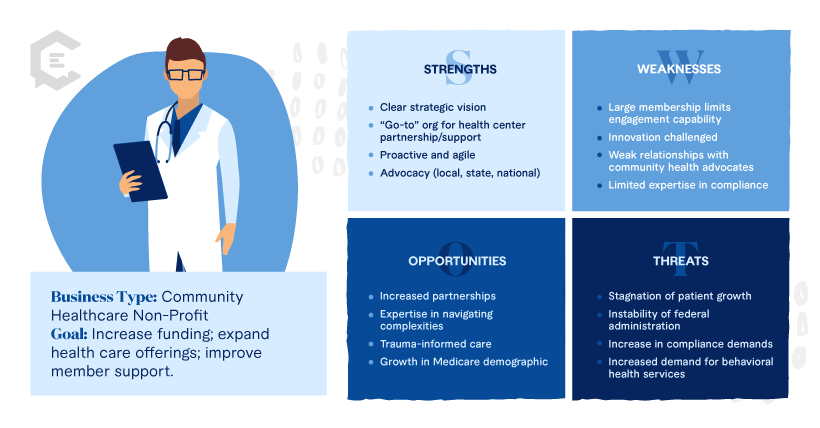What is SWOT analysis? As a tool for strategic planning, SWOT analysis is a review of your company’s or organization’s Strengths, Weaknesses, Opportunities, and Threats. Through the process of assessing where you stand in the marketplace, you can inform actionable insights to overcome obstacles and achieve goals.
“What are your strengths and weaknesses?”
This may well be one of the most popular — and maybe the most feared — questions you’ll ever hear in a job interview. It’s also among the most important questions you’re likely to be asked, and one that you should always be prepared to answer.
Now imagine applying this level of introspection to your small business or enterprise. If your business is doing well, it may be easy for you to identify what your strengths are — what your product or service brings to the marketplace that keeps customers coming back.
But just like in a job interview, knowing your strengths is only part of the story. Knowing your weaknesses, as well as identifying untapped opportunities and potential threats to your business equips you with the kind of market intelligence that can mean the difference between surviving and thriving.
What is SWOT analysis?
SWOT is an acronym that stands for Strengths, Weaknesses, Opportunities, and Threats. Through this framework, you can identify where you’re doing well and where you have room for improvement in your business, backed by data.
Think of it this way: A financial balance sheet gives you a snapshot of your company’s assets and liabilities at a specific point in time, providing actionable insights that can help you create a strategy to pay off short-term obligations based on available assets.
In a similar way, a SWOT analysis can provide this same level of insight about your position in the marketplace, and help you to create strategies for using strengths and opportunities to balance out — and potentially reduce or eliminate — weaknesses and threats.
Preparing for your SWOT analysis
Before you start on your SWOT analysis, here’s a quick guide to the supplies, people, and space — the what, who, and where — that you’ll need.
What you’ll need
Something to document your findings on, such as a whiteboard, giant sticky note pad, or an appointed scribe with a notepad. (OK, that last one was a who and a what, but you get the idea.)
Who you’ll need
If you are a solopreneur, grab a coffee and some snacks, and pull up a chair. If you are a team lead or manager, pull up enough chairs for all of your team members, and perhaps plan for a working lunch. And if you are in charge of a large enterprise, pull up chairs (and order lunch and snacks) for the key members of your leadership team responsible for setting company goals and establishing the strategies needed to achieve those goals.
Where you need to gather
A conference room, lunchroom, or any space with a whiteboard or with room to set up a giant notepad and easel will do. The idea is to find a space that’s quiet and free from interruptions and to block out enough time to walk through the process. And if sequestering in peace isn’t feasible? Consider going off-site for a half-day to complete this exercise without distraction. It really is that important.
SWOT analysis template
Now that you have the what, who, and where covered, here’s the how: Set up a simple matrix like the one shown below, and label each quadrant to correspond to the four components of SWOT:

You can capture the information manually on a hand-drawn chart, or create a digital version. Be sure to save your work (if digital), or snap a few photos of your completed SWOT analysis chart (if manual) before it is erased or discarded so you’ll have something to refer back to when you’re ready to take action on the information you’ve gathered.
Before deconstructing the SWOT matrix
Before you begin the work of deconstructing the quadrants that comprise the SWOT matrix, it’s a good idea to agree on some operating instructions. Please avoid some of the pitfalls and common SWOT analysis mistakes that can derail your efforts before you even begin.
Things to avoid during SWOT analysis:
- Adding long lists
- Overestimating strengths
- Generalizing factors
- Brushing over weaknesses
As you move through each quadrant, keep these additional tips in mind:
- Address both qualitative and quantitative items.
- Think about how to rank items in order of importance, such as establishing KPIs or other relevant metrics/measures. This will help you decide what to tackle first when creating your strategy.
Understanding the four quadrants of the SWOT analysis matrix
Now it’s time to put pen to paper (or pixels to printer) and begin filling out each section of your SWOT analysis matrix. In the sections that follow, we’ve unpacked each SWOT component a bit to help you get the process started.
1. Strengths
Identify what your team or your business does well. Include resources that keep you at an advantage over your competitors. Note what differentiates your business from similar organizations. And include positive attributes that are unique to your team or organization.
2. Weaknesses
Document areas for improvement and changes you can make internally to improve overall results. It’s important to be both objective and honest, so if you’re a team of one, consider asking others outside of your business to weigh in. You can create a survey to share with customers (useful for collecting information for all areas that comprise the SWOT matrix), or if you’re part of a large enterprise, solicit feedback from another team in the organization.
3. Opportunities
Identify trends or other changes in the marketplace that have the potential to become opportunities to help you grow your operation. Factors such as fluctuations in customer demographics, or regulatory changes can help you uncover untapped opportunities that you can turn into strengths.
4. Threats
When contemplating threats that can put your business at risk, consider factors that are beyond your control, such as changes in local, state, or federal regulations. Rather than just listing threats, be sure to look at the root cause of the threat so you can think through how to respond to, avoid, or even eliminate them.
The SWOT analysis process is meant to be simple, but let’s face it: getting into a rhythm of jotting down actionable attributes can be a bit overwhelming. MindTools.com has some great SWOT prompts you can use for each component of the matrix.
Questions to ask during SWOT analysis:
Strengths:
- What do you do well?
- What unique resources do you draw on?
- What do others see as your strengths?
Weaknesses:
- What can you improve?
- Where do you have fewer resources than others?
- What are others likely to see as weaknesses?
Opportunities:
- What opportunities are open to you?
- What trends can you take advantage of?
- How can you turn strengths into opportunities?
Threats:
- What threats could harm you?
- What is your competition doing?
- What threats do your weaknesses expose you to?
Applying SWOT analysis to your content marketing
In the same way that conducting a SWOT analysis can inform your overall business strategy, this same exercise can be applied more granularly to your content marketing efforts, and specifically to the development of your content marketing strategy.
When sitting down to map out your SWOT-informed content marketing strategy, consider the following tips.
Top SWOT tips for content marketers:
- Maintain success: Ensure you will continue to have the resources necessary to maintain the creation of appropriate content.
- Bring in reinforcements: Establish a plan to add headcount, redistribute work or bring in freelancers or agency partners, as demands for new content increase.
- Plan for the unknown: As new opportunities are discovered, consider whether more resources — both human and technical — will be needed to create new content.
- Expand your reach: Explore whether or not there are additional, untapped communication channels where you can expand your reach and potentially, the audience for your content.
- Identify content gaps: Look for the places where your competitors have established a presence and consider if addressing that gap is appropriate for your business and if doing so will put you at a competitive advantage.
- Create and maintain an editorial calendar: Your strengths can help you establish a regular cadence for publishing the content you know you’ll need to maintain your success. From there, consider what content will be needed (and when) to shore up any weaknesses that you’ve identified. Then, plan for content needed to seize opportunities. Don’t let a lack of planning turn into an internal — and avoidable — threat.
- Invest in training: As you anticipate market changes that will impact your business, calculate the investment you’ll need to make to keep your team equipped with the knowledge and skills needed to keep up with those changes.
- Technical obsolescence: As you consider content marketing channels, don’t forget to assess whether or not you have the tools and technology needed to ensure you’re able to continue publishing content in an efficient and expedient manner to those channels. Consider platforms like ClearVoice to scale your content efforts.

Apply SWOT analysis to long-term planning with Time Flow methodology.
Another way to act on the results of a SWOT analysis is to use what’s called the Time Flow Method, an original method created by Justin McKinley, former head of content at ClearVoice. This method can help you further organize your thoughts, as well as organize and inform what actions you take (and when) as you implement your content marketing strategy.
Here’s a list of the five flows at the core of the Time Flow method, along with examples of how to apply them to the results of your SWOT analysis:
1. Spontaneous — What can I do now?
SWOT application: The SWOT analysis and related strategic outcomes can be considered spontaneous behaviors in response to the “what can I do now” question.
2. Reactive — What must or should I do?
SWOT application: Consider content contingencies you can create to counter weaknesses (what you should do) and threats (what you must do).
3. Cyclical — What do I do again and again?
SWOT application: The predictability of cyclical behaviors can inform planning for the creation of strategic content needed to maintain your strengths and success over time.
4. Proactive — What can I plan to do?
SWOT application: Once you’ve identified opportunities as part of your SWOT analysis, the proactive flow can inform short-term projects that can help with the achievement of larger goals.
5. Envisioned — What can I ultimately achieve?
SWOT application: Envisioning can help you hone in on the creation of content needed to maintain strengths and identify long-term measures of success.
Leverage the levels of your brand experience when employing SWOT analysis
Defining the levels of content of your brand experience provides yet another structured approach you can apply when sorting through your strengths, weaknesses, opportunities, and threats, and when creating or rebooting your content marketing strategy.
A content level refers to the level of content in a brand hierarchy. These levels can be used to better understand the interconnectedness of the branded content you create for your organization.
There are 11 levels of brand content:
When structuring your content marketing strategy based on the results of your SWOT analysis, remember that the higher levels of content are closest to the core of your brand, while the lower levels are considered more supportive.
Because of the essential nature of the core level of content to the success of your business, you may be tempted to focus your strategy on core content offerings. This assumption isn’t necessarily wrong, but be sure to explore how you might address the other levels as well. For example, vertical content could be used to address new opportunities, or creating and using assets to proactively address — or respond to — threats that may arise in the marketplace.
3 examples of SWOT analysis
Now that you’re familiar with the ins and outs of how to perform a SWOT analysis, why it’s important, and what you can expect to get from walking through the process, let’s take a look at some examples of what a SWOT analysis might look like for three types of businesses.
Business type: Private yoga teacher
Goal: Expand teaching space and class offerings, and increase clients.
Strengths:
- Extensive training and education
- One-on-one instruction
- Inclusive, accessible teaching style
- Recognized body-positive trainer
Weaknesses:
- Only available part-time
- In-home studio/limited space
- Limited time to build business
- No space to teach group classes
Opportunities:
- Expand online instruction
- Collaboration with body-positive businesses, influencers
- Mindfulness training
- Community drop-in classes
Threats:
- Saturation of area yoga studios
- Group classes at lower cost
- Mainstream studios not open to body-positive teachers
- Cost of private instruction unattainable for some
Business type: Community healthcare non-profit
Goal: Increase funding; expand health care offerings; improve member support.
Strengths:
- Clear strategic vision
- “Go-to” org for health center partnership/support
- Proactive and agile
- Advocacy (local, state, national)
Weaknesses:
- Large membership limits engagement capability
- Innovation challenged
- Weak relationships with community health advocates
- Limited expertise in compliance
Opportunities:
- Increased partnerships
- Expertise in navigating complexities
- Trauma-informed care
- Growth in Medicare demographic
Threats:
- Stagnation of patient growth
- Instability of federal administration
- Increase in compliance demands
- Increased demand for behavioral health services
Business type: Public university
Goal: Rebrand, improve digital presence, and increase enrollment and retention.
Strengths:
- Nationally recognized programs and courses
- Award-winning faculty
- Low tuition/high value
- Diverse student body
Weaknesses:
- Lacking brand recognition
- Low student retention
- Low graduation rates
- Lack of/dated engaging digital experiences
Opportunities:
- Low tuition/high value to attract more students
- Build on strong national rankings
- Promote diversity and inclusion
- Leverage faculty in effective ways
Threats:
- Competition from larger, more established university systems
- Weak brand reputation
- Lack of differentiation from community colleges
- Limited national recognition
Every business needs a discovery phase
According to Douglas Karr of DK New Media, conducting a competitive analysis is an integral part of the discovery phase of an agile marketing journey. As Karr shared in a ClearVoice webinar:
“Before any journey begins, you must understand where you are, what’s around you, and where you are going. Every marketing employee, hired consultant, or agency must work through a discovery phase. Without it, you don’t understand how to deliver your marketing material, how to position yourself from the competition, or what resources are at your disposal.”
Ready to begin your journey?
Whether you’re in the discovery phase or looking for support in your current content strategy, ClearVoice can help. Our managed content creation and proven expert creators can help you maximize the potential of your content strategy’s impact. Talk to a strategist today to see how.






